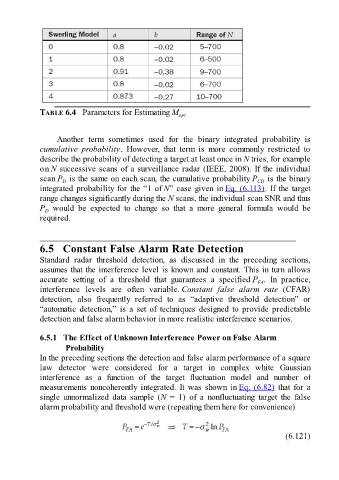Page 496 - Fundamentals of Radar Signal Processing
P. 496
TABLE 6.4 Parameters for Estimating M opt
Another term sometimes used for the binary integrated probability is
cumulative probability. However, that term is more commonly restricted to
describe the probability of detecting a target at least once in N tries, for example
on N successive scans of a surveillance radar (IEEE, 2008). If the individual
scan P is the same on each scan, the cumulative probability P is the binary
CD
D
integrated probability for the “1 of N” case given in Eq. (6.113). If the target
range changes significantly during the N scans, the individual scan SNR and thus
P would be expected to change so that a more general formula would be
D
required.
6.5 Constant False Alarm Rate Detection
Standard radar threshold detection, as discussed in the preceding sections,
assumes that the interference level is known and constant. This in turn allows
accurate setting of a threshold that guarantees a specified P . In practice,
FA
interference levels are often variable. Constant false alarm rate (CFAR)
detection, also frequently referred to as “adaptive threshold detection” or
“automatic detection,” is a set of techniques designed to provide predictable
detection and false alarm behavior in more realistic interference scenarios.
6.5.1 The Effect of Unknown Interference Power on False Alarm
Probability
In the preceding sections the detection and false alarm performance of a square
law detector were considered for a target in complex white Gaussian
interference as a function of the target fluctuation model and number of
measurements noncoherently integrated. It was shown in Eq. (6.82) that for a
single unnormalized data sample (N = 1) of a nonfluctuating target the false
alarm probability and threshold were (repeating them here for convenience)
(6.121)

